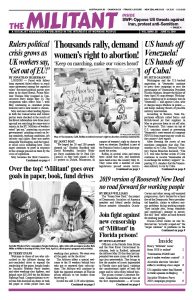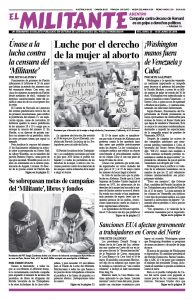Washington continues to levy sanctions, issue threats against Iran, and move military forces into the Mideast as it advances the predatory interests of the U.S. imperialist rulers in the region. Washington aims to force the Iranian government into talks to end its nuclear weapons program and pull back the armed presence of Tehran’s forces and its proxies in Iraq, Syria and elsewhere that has expanded the political and military reach of the Iranian capitalist class.
If the Iranian rulers “do something, it will be met with great force,” said President Donald Trump May 20, increasing tensions between Washington and Tehran that are dangerous for working people in the U.S. and across the Mideast.
The government announced it was sending a further 1,500 troops, a fighter aircraft squadron and a missile defense system to the region May 24. This comes on top of the vast firepower U.S. imperialism already deploys across the Mideast — 50,000 troops with their warplanes, warships, missile and bombs — to enforce its will.
While making threats, Trump also says Washington doesn’t seek a war. Trump told Pentagon officials May 15 that “he does not want the intensifying American pressure campaign against the Iranians to explode into open conflict,” reported the New York Times.
“I think we’ll make a deal,” he said while on a state visit to Japan May 27. “We’re not looking for regime change. I just want to make that clear.”
Iran’s reactionary capitalist rulers have expanded their economic and military influence through intervention into conflicts in the region, pressing workers and farmers into their armed forces, and organizing militias in Iraq, Syria, Yemen and elsewhere. Deepening outrage among working people in Iran over the bloody consequences of Tehran’s military incursions lay behind protests and strikes that spread to 90 cities and towns across the country early last year, before they were put down by the regime.
Unrest among working people in Iran continues. They face double-digit unemployment, double-digit inflation and — like workers in the U.S. — growing inequality between the capitalist rulers, backed by their upper-middle-class retinues, and workers and farmers. Some 57 million Iranians live in poverty and the economy continues to shrink.
Trade unionists who mounted an International Workers Day action outside the Iranian parliament were arrested, Al-Monitor reported.
For nearly four decades Iran’s capitalist rulers sought to consolidate the counterrevolution they carried out at home — to push back the workers, farmers, women and oppressed nationalities who made the 1979 Iranian Revolution — by extending their reactionary reach abroad.
Sanctions hit working people hardest
Washington’s steps to tighten sanctions on Iran have intensified the worsening conditions bearing down on workers and farmers there. Since the U.S. government’s sanctions were reinstated last year, the rial has lost 60% of its value against the dollar. The cost of basic food items has risen by as much as 57% and housing and medical service costs are up 20%.
The capitalist rulers in Tehran recently brought armed units from Hashd al-Shaabi in Iraq, Hezbollah in Lebanon and Afghan militia fighters deployed in Syria to parade in southern Iran. One Iranian clerical leader said this was a “warning” to the people that the regime will use whatever means necessary to stay in power.
Military conflicts across the region, where Tehran and Washington support opposing sides, continue. After suspending air raids on Saudi Arabia last year, Tehran-backed Houthi forces in Yemen have stepped up missile and drone strikes on Saudi cites and airports since the U.S. began moving military personnel and equipment to the Middle East this month.
The rulers of Saudi Arabia have carried out deadly airstrikes on Houthi forces, seeking to restore the rule of deposed President Abed Rabbo Mansour Hadi. As a result of the carnage inflicted on working people during Yemen’s civil war nearly half the population live in famine. Washington provides warplanes, bombs, arms and intelligence to the Saudi monarchy.
Under terms of a U.N.-brokered truce in the Yemeni port of Hodeida reached last year, humanitarian aid has been able to reach some of those impoverished by the war and Houthi attacks on Saudi targets had largely subsided.
In recent weeks Houthi combatants have launched a series of drone bombings on Saudi targets, including the country’s main oil pipeline. They have also attacked the Najran airport near the Saudi border with Yemen three times.
In response, Saudi bombers have carried out a wave of attacks on Sana, Yemen’s capital, which is occupied by the Houthis. One pulverized a crowded residential area May 16, killing and wounding a few dozen, including 19 children.

